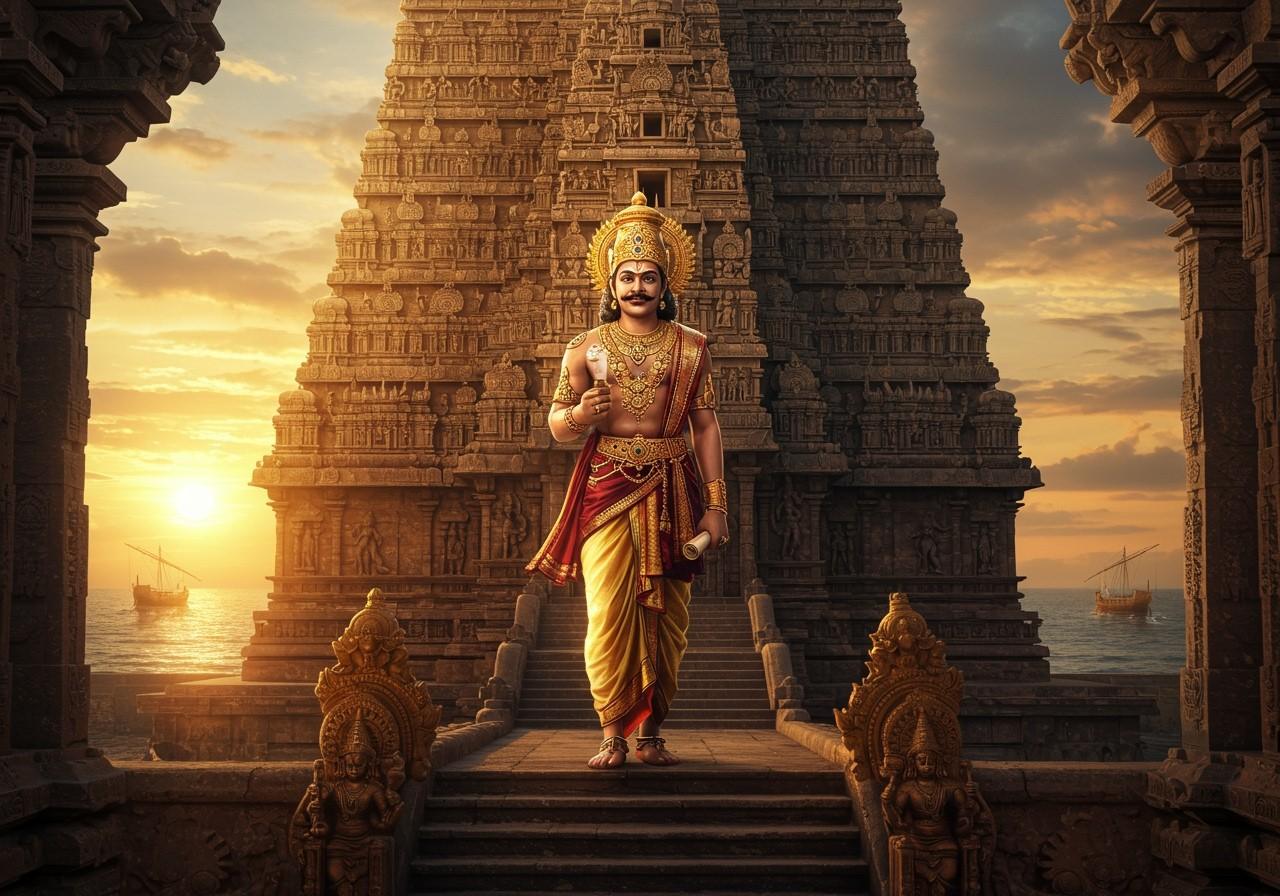
Raja Raja Chola I, a remarkable figure in Indian history, left an enduring legacy. His reign, spanning from 985 to 1014 CE, was a period of significant cultural and architectural achievements. Let’s delve into his contributions and understand why he remains revered among Indians today.
Early Life and Ascension
Born Arun Mozhi Varman around 947 CE to King Parantaka II and Queen Vanavan Mahadevi, Raja Raja Chola I belonged to the illustrious Chola dynasty of southern India. His upbringing included rigorous education and military training, shaping him into the leader he was destined to become. He ascended the throne in 985 CE during a time of instability, skillfully solidifying his position and ushering in an era of prosperity.
Military Conquests and Expansion
Raja Raja Chola I was a brilliant military strategist. His campaigns against the Chera and Pandya kingdoms consolidated Chola dominance in southern India. He extended the empire’s reach overseas through naval expeditions, conquering parts of Sri Lanka, the Lakshadweep islands, and the Maldives. His strategic alliances and innovative military tactics were instrumental in his success. He transformed the Chola kingdom into a powerful empire, his influence felt far beyond its traditional borders.
Cultural and Architectural Contributions
A great patron of arts and architecture, Raja Raja Chola I fostered a cultural renaissance within the Chola empire. The magnificent Brihadishvara Temple, completed in 1010 CE and dedicated to Lord Shiva, stands as a testament to his architectural vision. This UNESCO World Heritage Site showcases the architectural prowess of the Chola period. His support for Tamil literature further enriched the cultural heritage of the empire, leaving an indelible mark on the region’s artistic landscape.
Administrative Achievements
Raja Raja Chola I implemented key administrative reforms to strengthen his empire. He established a centralized bureaucracy and a streamlined revenue system. Land surveys and meticulous record-keeping ensured fair taxation and efficient governance, contributing to the overall prosperity and stability of the empire. His administrative reforms created a model for future rulers, demonstrating his foresight and understanding of effective governance.
Legacy and Influence
Raja Raja Chola I’s legacy is profound and far-reaching. His reign set the stage for future Chola rulers, including his son, Rajendra Chola I, who continued his expansionist policies. His influence on South Indian politics, culture, and religion is undeniable. He is celebrated in contemporary art, literature, and popular culture, a testament to his enduring impact on Indian history.
Death and Historical Significance
Raja Raja Chola I passed away in 1014 CE. The exact circumstances surrounding his death remain a subject of historical debate. His son, Rajendra Chola I, succeeded him, carrying forward his father’s legacy. Raja Raja Chola I’s historical significance extends beyond India, his reign influencing world history through his remarkable achievements in empire-building, cultural development, and architectural innovation.
How Poojn.in Helps Honor the Legacy of Raja Raja Chola I
At Poojn.in, we offer a wide selection of authentic puja items that connect you with the rich spiritual traditions championed by rulers like Raja Raja Chola I. Our collection includes items reminiscent of those used in the Brihadishvara Temple and other sacred spaces:
- Pure brass and copper lamps: These beautifully crafted lamps, similar to those used in ancient temples, bring a sacred glow to your puja space. We offer a variety of sizes and designs to suit your needs, ensuring a high-quality and authentic experience.
- Traditional kumkum and vibhuti holders: These ornate holders add a touch of elegance to your puja rituals. Crafted with care, they preserve the sanctity of these sacred powders, enhancing your connection to tradition.
- Panchaloha items: Crafted using the ancient five-metal alloy, these items possess a unique spiritual significance. From idols to puja accessories, our panchaloha collection offers a tangible link to the past.
- Temple-grade camphor and sambrani: Enhance the atmosphere of your puja with the pure and aromatic fragrances of temple-grade camphor and sambrani. These sacred substances purify the air and create a serene ambiance for worship.
- Pure copper kalash and vessels for abhishekam ceremonies: Perform traditional abhishekam rituals with our high-quality copper kalash and vessels. These items are crafted to traditional specifications, ensuring authenticity and purity.
We deliver these sacred items across India, making it convenient to uphold religious practices in modern times. We offer bulk purchasing options for temples and institutions. Our dedicated customer service team is available to guide you on the proper usage and maintenance of our ritual items. Visit Poojn.in to explore our complete collection and preserve your cultural heritage.
FAQs on Raja Raja Chola I
When was Raja Raja Chola I born? Raja Raja Chola I was born around 947 CE.
What made Raja Raja Chola I famous? His military conquests, the construction of the Brihadishvara Temple, and his administrative reforms cemented his place in history.
When and where did Raja Raja Chola I die? He died in 1014 CE in Thanjavur, the capital of the Chola Empire.
What is significant about Raja Raja Chola I’s dynasty? His reign marked the transformation of the Chola kingdom into a powerful empire, influencing South Indian politics, culture, and religion for centuries.
What was Raja Raja Chola I’s contribution to architecture? The Brihadishvara Temple is his most significant architectural achievement, a marvel of Dravidian architecture.
Explore more about Dravidian architecture and temples:
- Dravidian and Nagara Architecture: A Comparison of Styles
- Dravidian Temples: A Guide to Their Key Architectural Features
- Exploring Dravidian Architecture: South India’s Ancient Temples
- Dravidian Temples: Their Role in Hindu Rituals
- Modern Dravidian Architecture: New Designs and Interpretations
Conclusion
Raja Raja Chola I’s life and reign epitomize strength, vision, and cultural richness. His legacy continues to inspire, reminding us of the enduring power of tradition, leadership, and cultural pride.


